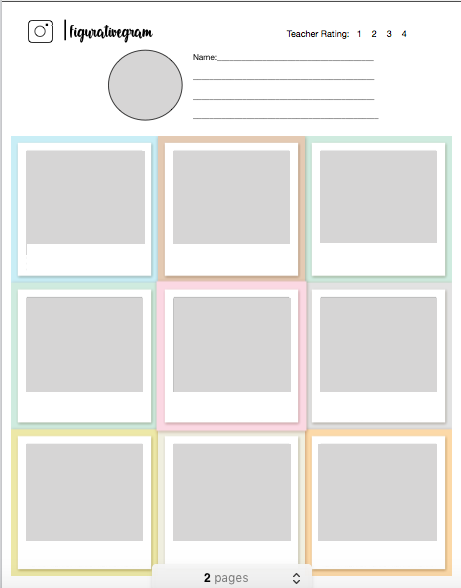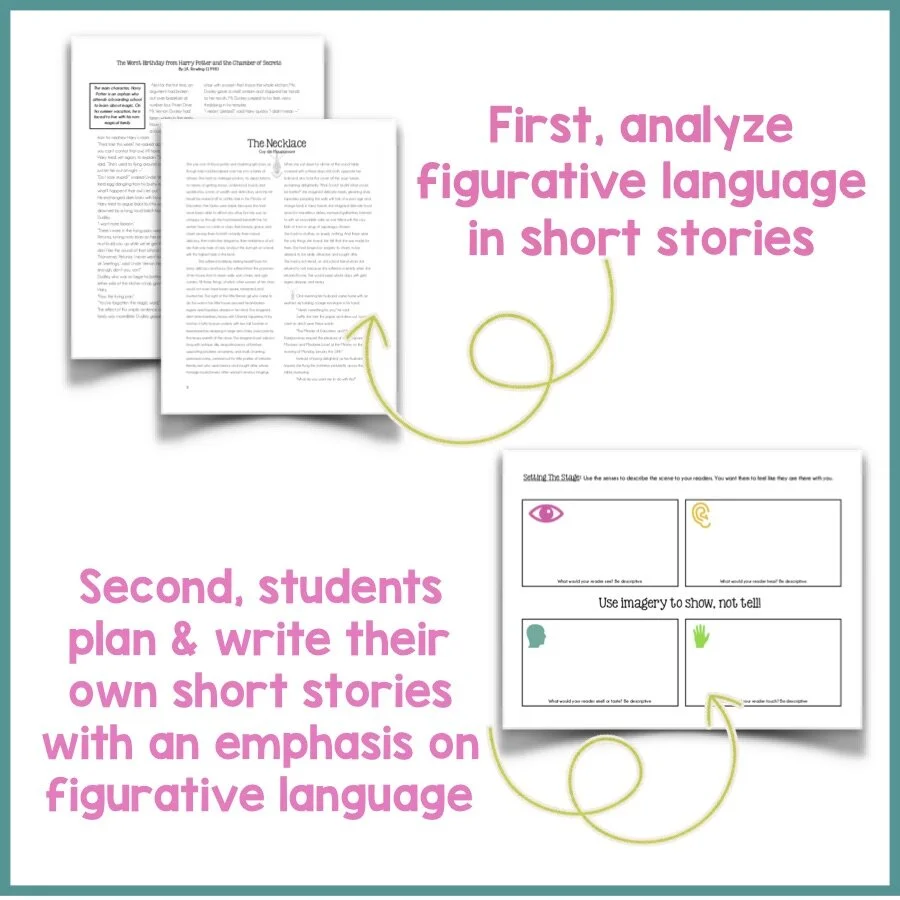5 Steps to Help Middle School Students Develop an Understanding of Figurative Language
Figurative language is one of my favorite things to teach!
Since it is found everywhere, it is one of the first standards we focus on in class.
I thank if we can start off the year with a deep understanding of this concept, I can refer back to it again and again as we go through the year.
The big thing I focus on with the figurative language standard is MEANING. After the first initial review of figurative language terms, I rarely go back to it since I want them to focus on the WHY we have figurative language and what the author is trying to accomplish with the figurative statements.
I get so excited about figurative statements! When we read something aloud in class, like THE BEST line from the novel Chains where Isabel states, “she cannot chain my soul.” I make everyone stop, appreciate the beautifully written words, talk about their meaning, and I tell them I wish I could write lines like that that can live inside you forever. At this point, I usually get blank stares from my 8th graders, but they can feel my genuine love for the words and I hope that stays with them.
Before we get to that point, though, there are the five steps I have to teach figurative language to my middle school students,
Figurative Language Hook Activity: Click Image for Activity
Recently I ask my daughter and son what their favorite shows are and they name channels on Youtube. If you have children, I am sure it’s the same for you. I’m sitting over here like, “why are you watching someone open a toy on Youtube when you have tons of toys you can play with right here?!” Anyway…
It’s such a different time compared to basic cable I had growing up. Since the world and information is basically at their fingertips, I decided to hook my students into the figurative language unit with their favorite medium, Youtube.
I made a scavenger hunt sheet with the figurative language terms, set a time limit, 45 minutes, and tasked the students with finding the best videos that teach each concept. From the video they had to be able to define the word, give an example from the clip, and then be able to come up with their own example. This turned out to be a great review of the terms, meaning, and examples. They loved calling me over to show me what they found!
2. Review the Terms:
Although, it’s not my favorite part of the unit, it has to be done.
I have a quick mini lesson that gives the terms, definitions, and examples.
After that, I give each table group a sorting activity. They work together using their notes to match the terms to the examples. I allow them to use their notes the first couple of rounds and then see who can do it without notes the fastest. It’s old school, but it works!
Finally, I have station activities where students work more in depth with the terms. For example, the first quest has students determining if the sentence is a simile or not. I don’t know about you, but a lot of my students think just because the sentence has LIKE in it, it must be a simile. This activity helps set them straight!
After we do all of that, we review with a BINGO game. It has examples of figurative language in each box, and I call out a term, like personification, and they have the find the example and put a marker on it. Then it’s quiz time to make sure they have the foundation before we move on. But that being said thought, I do not hold students up in this stage since if they do not demonstrate mastery of terms since my overall goal is for them to understand the meaning of the statement.
3. Figurative language Bell ringers:
This second activity definitely the rockstar of my figurative language unit. After I know we have the foundation down, I start each class with a song. I show them a what I call a cryptic figurative lyric. After we talk about it for a minute or two, the students have to write 1 sentence about what the lyric means and 3 sentences about how they can relate to it. While they are writing, I play the song. It’s great y’all. Seriously. I don’t know if it’s the music playing, or the fact they can write about themselves, but my students love this part of the day!
When I went to the Model Schools Conference and learned about rigor and relevance, I came back with the goal of revamping my standards instruction with more relevance. With the figurative language standard I knew I could always do the song lyrics and have them pick their favorite songs, but I wanted to add to it.
So, I came up with The Figurativegram. Yep. It’s as cool as it sounds. Basically, students create a mock Instagram account on paper or google slides. For each image included on their ‘’gram”, they have to write a caption that includes figurative language. I can not tell you how much fun this project is. The stuff they come up with is usually so creative and their pictures are great, too!
And a bonus to this activity is you get to build relationships with your students. I learn more about them through their pictures and get a better understanding of who they are.
5. Applying Figurative Language
This is the activity my students think is the most challenging. But, as I remind my ELA lovelies all the time, rigor is good! It means their growing and learning! When they’re grumbling and being a little whiny, I ensure them the hard work is going pay off in the end!
To get the ball rolling and get them in the groove of creative writing, I put them in groups of 3-4. Each group gets a random story starter sheet and a set of 8 envelopes (inside the envelopes are figurative language terms). I set the timer for about five minutes and the group starts working on their story. When the timer goes off, they have to select a random envelope, open it, and somehow include the figurative language term into their story before the timer goes off again when they have to select another random envelope. For example, when the timer goes off and the group selects an envelope, opens it to find the word IMAGERY, they have to come up with a way to add imagery to their story before the next timer goes off. Adding the timer and random component really makes this story writing activity fun, difficult, and engaging!
After this activity, I have my students work in partners. First, we read short stories like the Necklace and excerpts from Harry Potter. As we read, we highlight examples of figurative language. They talk in their group about how it impacts the story and what it would be like without the figurative language. Then, they work together to create their own story from start to finish. They have to include figurative language in their descriptions of the setting, characters, feelings, and motivations. After they write their story, the groups write their own multiple choice figurative language test. It must include figurative statements from their own story and 4 answer choices about the meaning of the statement.
For example, a student might write for one of their questions: what is does the author mean by this statement, “she did not see the lion inside of me.” They always seem to struggle to come up with answer choices that are plausible, but I encourage them to reread the statement and think about the literal and figurative meaning.
It’s challenging, but at the end of the whole unit, they have a clearer and deeper understanding about the purpose of figurative language. And to me, that’s the goal of teaching figurative language in middle school.
I hope these five ideas help you get some ideas on how to approach figurative language in your classroom. I know you can create all of this on your own because you’re amazing! However, if you want to save some time, I have a link to all of the items I’ve talked about in this post!
Here is a link to all of the activities
(plus an assessment and a few other goodies) in a nice little bundle for you!
If a bundle is not your style, I hear you! I have linked each item in the descriptions.
Speaking of time, if you are looking for more of it, I can help with that! Unlimited ELA! Is where you need to be! Unlimited and standards based lessons, activities, vocabulary, and more available for download when you want, as many times as you want, for whatever ELA need you have. All for only $12 a month. For real, people are saying it’s the best thing they’ve done for their classroom. Check it out here!
Also, because I love my teacher friends, here is a figurative language cheat sheet for you! It includes all of terms you should cover in your language arts classroom along with the definitions, and a space to write your notes. #yay!
Keep rocking that classroom,
Savannah Kepley









